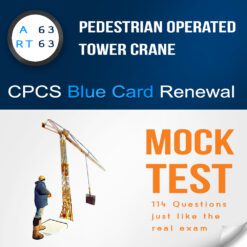RT63 CPCS Blue Card Renewal Mock Test with 114 Questions and Answers / A63 Pedestrian Operated Tower Crane (POTC)
£15.00 Original price was: £15.00.£9.95Current price is: £9.95.
Why Choose Our A63 POTC Renewal Mock Test for Your CPCS Blue Card Extension?
- Questions & Answers: based on the latest RT 63 Pedestrian Operated Tower Crane – CPCS Renewal Test Revision FACTSHEET
- Categories: A63 – POTC / Self-erectors
- Number of Multiple-choice Questions: 114
- Format: PDF
- Delivery time: Instant download after checkout
- Refunds: No refunds once downloaded, unless you ordered duplicates by mistake.
If there are any issues with your download, please email CardRenewalTest@gmail.com and we’ll send it ASAP
Ace Your CPCS Blue Card Renewal with Our RT63 Pedestrian Operated Tower Crane Mock Practice Test
Are you a Pedestrian Operated Tower Crane (POTC) operator looking to renew your CPCS Blue Card? Have you struggled with the theory test in the past or are you simply seeking a comprehensive study aid to ensure success? Look no further! Our RT63 Pedestrian Operated Tower Crane CPCS Blue Card Renewal Mock Practice Test is designed just for you.
Renewing your CPCS Blue Card is crucial for extending your career and ensuring that you meet the industry’s competency standards. The RT63 Renewal Test, based on the latest NOCN CPCS factsheet, is a key step in this process. It evaluates your knowledge of safe crane operation, lifting procedures, stability, and much more.
The Challenge of Traditional Study Methods
Studying for the CPCS Blue Card Renewal Test can be overwhelming, especially if you’re faced with extensive factsheets and dense regulatory text. Traditional study methods may not cater to everyone, leaving you in search of a more effective and engaging solution.
Your Solution: RT63 Renewal Mock Practice Test
1. Comprehensive Coverage of RT63 Renewal Topics:
Our mock test includes 114 multiple-choice questions meticulously crafted to cover every aspect of the NOCN CPCS RT63 Pedestrian Operated Tower Crane factsheet. From pre-use checks to stability considerations, you’ll be well-prepared for the actual test.
2. Realistic Test Simulation:
Experience the actual test environment with questions designed to closely resemble the format of the CPCS Blue Card Renewal Test. This ensures that you’re comfortable and confident when the real test day arrives.
3. Flexible and Accessible Learning:
Our mock test is accessible online, allowing you to practice at your own pace and convenience. No need to sift through lengthy texts – focus on targeted questions to enhance your comprehension.
4. Boost Confidence and Minimize Stress:
By familiarizing yourself with the question types and content, our RT63 Renewal Mock Practice Test helps boost your confidence, reducing stress on test day. Feel more at ease and ready to tackle any question that comes your way.
How to Pass Your CPCS Blue Card Renewal Test: A Step-by-Step Guide
- Study Smart, Not Hard:
- Focus on targeted questions to reinforce specific knowledge areas.
- Use the detailed explanations to deepen your understanding.
- Simulate Test Conditions:
- Practice in an environment that mirrors the actual test to build confidence.
- Learn from Mistakes:
- Review incorrect answers and understand the correct solutions.
- Turn mistakes into opportunities for improvement.
- Consistent Practice:
- Regularly revisit the mock test to solidify your knowledge.
- Track your progress and areas of improvement.
Invest in Your Career Today
Renewing your CPCS Blue Card is an investment in your career longevity and safety. Our RT63 Renewal Mock Practice Test is the ideal tool to help you achieve success and extend your blue card for another five years.
Disclaimer: Our mock test is designed to supplement your study efforts. Success in the CPCS Blue Card Renewal Test also requires a thorough understanding of practical aspects, hands-on experience, and adherence to industry safety standards.
This summary covers the key learning points from the RT63 Pedestrian Operated Tower Crane factsheet.
Preparation and Completing Work (Preparation):
- POTCs, or self-erectors, consist of a mast and jib section, usually mounted on a trailer-type chassis, unfolded, erected, and operated from ground level.
- Controls are operated through a unit worn by the operator, either via an umbilical cord or radio signals.
- Proper pre-use checks are mandatory, with intervals for operator and hirer’s maintenance team involvement.
- Failure to check all parts and components can lead to incidents or injuries due to performance and safety faults.
- Essential checks for POTCs with outrigger legs to ensure stability and prevent sinking into the ground.
- Legislation mandates the creation of a lift plan detailing risks, mitigating measures, and load weights.
- All personnel, including operators, must be aware of lift plan contents, and concerns should be relayed to the lift supervisor.
Working Safely and Others (Working Safely):
- Segregation of the lift and load placing area from pedestrians, considering public access.
- Avoiding moving suspended loads above workers or pedestrians; use additional measures if unavoidable.
- Planning crane position to keep clear of overhead power lines, adhering to energy networks’ minimum distance guidelines.
- Caution needed when slewing with a load near the rated capacity to avoid side stress and overshooting.
- Regular monitoring of wind speeds to operate within authorized limits, considering variations at height.
- Considering gusts of wind, especially for large surface area loads, and communicating wind speeds to the crane supervisor.
- Remote-controlled POTCs recommended not to sling loads for safety reasons.
- Care needed when following the load’s path during slewing or changing radius to prevent accidents.
- Checking ground conditions before work in case of soft ground due to heavy rain.
Attaching and Lifting Loads (Working Tasks):
- Lifts should be planned, and POTC must stay within the rated lifting capacity for the relevant configuration.
- Crane’s rated capacity indicator (RCI) warns the operator and must not be overridden during lifting operations.
- Tower cranes, including POTCs, designed to lift loads vertically, requiring the hook to be directly above the load’s center of gravity.
- Rated capacity applies only to freely suspended loads and not at all times or situations.
- Operators must be aware of load constitution and how specific types should be slung, using the correct lifting accessory.
- Being remotely operated, operators should consider erratic crane movements, especially near full radius.
Stability:
- Effective planning considering ground, working area, and environmental factors to prevent POTC instability.
- Identifying or calculating load weight to prevent instability due to overloading.
- Uncontrolled swinging of heavy loads can cause the crane to become unstable.
- Checking ground conditions and support base strength for stability, using spreader or support mats to reduce outrigger pressure.
4 reviews for RT63 CPCS Blue Card Renewal Mock Test with 114 Questions and Answers / A63 Pedestrian Operated Tower Crane (POTC)
Add a review Cancel reply
Related products
CPCS Blue Card Renewal Tests
RT17 CPCS Blue Card Renewal Mock Test with 144 Questions and Answers / A17 Telescopic Handler
CPCS Blue Card Renewal Tests
CPCS Blue Card Renewal Tests
RT12 CPCS Blue Card Renewal Mock Test with 130 Questions and Answers / A10, A12 Excavator 180°
CPCS Blue Card Renewal Tests
RT37 CPCS Blue Card Renewal Mock Test with 122 Questions and Answers / A37 Trencher
CPCS Blue Card Renewal Tests
CPCS Blue Card Renewal Tests
RT49 CPCS Blue Card Renewal Mock Test with 141 Questions and Answers / A49 Loader Securer non STGO
CPCS Blue Card Renewal Tests
RT41 CPCS Blue Card Renewal Mock Test with 118 Questions and Answers / A41 Loader Compressor
CPCS Blue Card Renewal Tests
RT33 CPCS Blue Card Renewal Mock Test with 129 Questions and Answers / A33 Agricultural Tractor

















Sony –
Good
Leila Gupta –
Got it for my boyfriend and he found it useful for the exam
Elizabeth –
Good to read before the potc renewal test
Adam –
I had just renewed a few different categories and used these practice questions before going to the test. It was. It actually helps